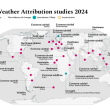Global coal demand is expected to plateau through 2027 despite a record 8.77 billion tonnes consumed in 2024, driven by increased adoption of renewable energy sources, according to the International Energy Agency. The Coal 2024 report by EIA attributes this stabilisation to the rapid deployment of clean energy technologies, which are reshaping electricity systems worldwide.
China, the world’s largest coal consumer, plays a central role in this trend. For one-third of global coal consumption, China’s expanding nuclear, solar PV, and wind capacity is expected to limit further increases in coal use. However, weather-related fluctuations in renewable generation could lead to variations in China’s coal demand, with potential swings of up to 140 million tonnes by 2027.
“The rapid deployment of clean energy technologies is reshaping the global electricity sector, which accounts for two-thirds of the world’s coal use. As a result, our models show global demand for coal plateauing through 2027 even as electricity consumption rises sharply,” said Keisuke Sadamori, IEA Director of Energy Markets and Security.
Sadamori added, “However, weather factors – particularly in China, the world’s largest coal consumer – will have a major impact on short-term trends for coal demand. The speed at which electricity demand grows will also be very important over the medium term.”
Coal demand in advanced economies has already peaked and is projected to decline further, driven by robust policy measures, such as those in the European Union, and the availability of alternative energy sources like natural gas in North America. Conversely, emerging economies including India, Indonesia, and Viet Nam are experiencing rising coal demand, fuelled by economic growth and increased electricity needs, with industrial use also contributing to the trend.
International coal trade volumes reached a record 1.55 billion tonnes in 2024, with Asia remaining the primary hub for imports and exports. China, India, and Japan lead the list of major importers, while Indonesia and Australia dominate exports. However, thermal coal trade volumes are expected to decline over the coming years.
The report also notes that coal prices remain 50% higher than the 2017-2019 average, with production hitting record levels in 2024. However, production growth is anticipated to flatten through 2027 as structural shifts in global energy systems take hold.






















